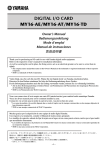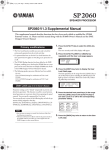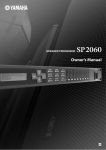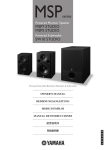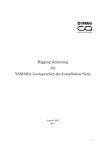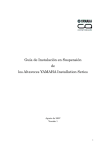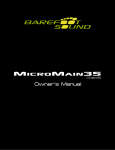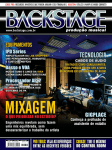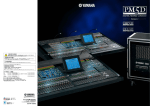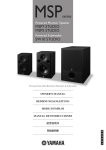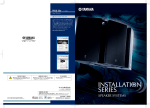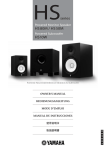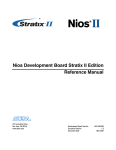Download Yamaha White Paper (Installation Series Speakers) Reference Guide
Transcript
A White Paper Of The Installation Series Loudspeakers YAMAHA CORPORATION PA·DMI Division, Advanced System Development Center A White Paper Of The Installation Series Loudspeakers We made the simple test for measuring the phase 1 Introduction characteristics using two 2-way speaker systems. The ease with which a speaker system can be adjusted to match the characteristics of a facility is of the utmost importance to sound contractors and engineers. In the same way that a painter's canvas must be white in order to show the true colors of his paints, a speaker system must be a "white canvas" in the sense that it accurately reproduces the waveforms provided as input and responds in a linear fashion to equalization − in audio terms it needs to provide a "flat response". The two most common causes of such uneven response are "comb filter" caused by the Figure 1 shows the setting. Speaker system A has 60 degrees x 40 degrees (horizontal x vertical) of the high frequency directivity, while speaker system B has 90 x 50. The amplitude response is almost the same. When driving both speaker systems that have the same phase characteristics simultaneously, the relative S.P.L. increases by 6dB at all frequencies, as shown in Figure 2. We then changed the phase characteristics of speaker system B and made measurement. The result is shown in Figure 3. In the frequency range where the phase difference is more than 120 degrees, significant cancellation is observed installation or architectural condition and "difference between the phase characteristics of the speakers". The former must be considered in the aspect of the system design such as speaker angle, etc. The latter should be considered as the important matter for making the Yamaha speaker system as "white canvas". in the amplitude response (you can see the cancellation in the range where the phase difference is between 120 and 240 degrees). In the frequency range where cancellation is observed, the equalizer does not respond in linear so it is very difficult to improve the frequency characteristics using the equalizer. <Figure 2: Driving two speaker systems that have the same phase characteristics> <Figure 1: Speaker measurement condition> Amplitude Speaker A Relative S.P.L. [dB] 10dB 6ft 6ft Speaker A Speaker B A+B Speaker B 100 1000 Frequency [Hz] -2- 10000 A White Paper Of The Installation Series Loudspeakers Yamaha thought that "even if different speaker Phase models are used in a system, we should offer a 180 150 "white canvas" and paid attention to the phase 120 Phase [Degree] 90 characteristics, aiming for the unification of the 60 30 0 phase characteristics through the series. As for -30 -60 Speaker A Speaker B A+B -90 -120 -150 sound quality, we aimed for both the clearness of speech (PA) and the high-fidelity sound -180 100 1000 Frequency [Hz] 10000 reinforcement of vocals/musical instruments, while the unification of the tone color (Family <Figure 3: Driving two speaker systems that have different phase characteristics> Sound Concept) of all products in the series was the basic concept. Also , we made a great effort to reproduce the Amplitude natural dimensions of the sound image. Relative S.P.L. [dB] 10dB In other words , the size of image must be an accurate representation of the source , particularly with regard to speech. In short, the design Speaker A Speaker B A+B 100 concept of the "Installation" series is to realize the 1000 10000 concepts for the phase characteristics and tone color. Frequency [Hz] Phase The following explains the details of our concept, 180 150 as well as how to realize the concept. 120 Phase [Degree] 90 60 30 0 -30 -60 -90 -120 -150 Speaker A Speaker B A+B -180 100 1000 Frequency [Hz] 10000 2 Consideration of speaker phase characteristics This problem happens not only between the same In a design of “the installation series”, we speaker models but also between the different investigated the influences of phase speaker models. characteristics of speakers into their responses at For example, in a live concert, it is common to receiving points at first. make speaker arrays using the multiple same speaker systems. However, in a facility, it is common to use different speaker models together. -3- A White Paper Of The Installation Series Loudspeakers 1) About phase characteristics between drivers <Figure 4: Influence of the phase difference to the amplitude response> Even a single speaker system may have the outLF drivers of a 2-way speaker system). Figure 4 shows the phase response of a 2-way Relative S.P.L. [dB] of-phase problem (for example, between HF and 10dB Low High Low+High speaker system. The cutoff frequency is 1.5 kHz 100 1000 for both the HPF (18 dB/oct, BW) and LPF (18 10000 Frequency [Hz] dB/oct, BW). 180 Let's focus on 1.5 kHz frequency now. 150 120 see that 1.5 kHz frequency sound is reproduced both by the HF and LF drivers. From the graph of 90 Phase [Degree] From the graph of the amplitude response, you can 60 30 0 -30 -60 -90 Low High Low+High -120 the phase response, you can see that the phase -150 -180 100 difference between HF and LF is 180 degrees. 1000 Frequency [Hz] 10000 Both signal levels are equal so both cancel each other and in result, the dip is created in the <Figure 5: Response of a speaker system that has in-phase amplitude characteristics. Also in the overall units> phase response graph, you can see that the phase result, the speaker system has a bad phase characteristics around the crossover point. Relative S.P.L. [dB] suddenly changes between 1 kHz and 2 kHz. In 10dB Low High Low+High 100 Figure 5 shows the phase response of the same 2- 1000 10000 Frequency [Hz] way speaker system as Figure 4, however, the speaker system is adjusted for reducing the phase 180 150 120 difference in the range between 1 kHz and 2 kHz characteristics is constant over the whole range, Phase [Degree] within 90 degrees. The slope of the phase 90 60 30 0 -30 -60 -90 so the bad influence to the amplitude -120 characteristics is minimized. -180 -150 100 The "installation" series has smooth phase response that has the constant slope over the whole range. -4- Low High Low+High 1000 Frequency [Hz] 10000 A White Paper Of The Installation Series Loudspeakers the phase difference is within 120 degrees at 1 2) Discussion on phase response when multiple speaker systems are used kHz or less frequency. It is thought that, under this amount of phase difference, interference For installation to a hall, theater, church, etc., can be ignored. Therefore, in this condition, it multiple speakers may be stacked in arrays. is very important to match the phase In such conditions, there may be a problem in characteristics of two speakers in order to get the overlapped area where more than one the amplitude characteristics with no dip (as speaker covers. That is, as described in 2-1) with the discussion of phase characteristics above, there may be a dip in the amplitude between drivers described earlier). response. (Note that, practically, because the directivity This is because of the phase difference that is of a speaker changes depending on frequency, caused by the distance difference between the you have to consider frequency, directivity and speaker position and the listening position. distance.) Therefore, from the view point of the system <Figure 6: Considering the characteristics in the overlapped area> design, it is very important to reduce the overlapped area but actually it is very difficult L to perfectly eliminate it. Under the condition where two speakers are used as shown in Figure 6, Table 1 shows the relation between the "distance difference" and "out-of-phase 2ft θ frequency". The distance difference shows the Overlap Area dl difference between the distances from these speakers to the testing point. The frequency shows the point where the phase difference caused by the distance difference is 90 degrees. <Table 1: The relation between the distance difference and The parameter θ is the angle with the center out-of-phase frequency in the overlapped area> axis. θ 5 Table 1 indicates the following. When the overlapped area is within 10 degrees, 10 the phase difference caused by the distance 15 difference in the overlapped area is within 90 20 degrees at 1 kHz or less frequency, regardless L=6 m 0,174 / 3 3252 Hz 0,347 / 1.627 Hz 0,517 / 1.087 Hz 0,683 / 817 Hz L=12 m 0,174 / 3.249 Hz 0,347 / 1.626 Hz 0,517 / 1.086 Hz 0,684 / 816 Hz Phase difference = 90 degrees of the distance from the sound source. When the overlapped area is within 20 degrees, -5- L=24 m 0,174 / 3.248 Hz 0,347 / 1.626 Hz 0,518 / 1.085 Hz 0,684 / 816 Hz A White Paper Of The Installation Series Loudspeakers affected by the dip caused by the interference θ 5 10 15 20 L=6 m 0,087 / 4.336 Hz 0,174 / 2.170 Hz 0,261 / 1.449 Hz 0,347 / 1.089 Hz L=12 m 0,087 / 4.332 Hz 0,174 / 2.168 Hz 0,261 / 1.448 Hz 0,347 / 1.088 Hz L=24 m 0,087 / 4.331 Hz 0,174 / 2.167 Hz 0,261 / 1.447 Hz 0,347 / 1.088 Hz expands, as well as the dip frequency lowers. When the phase difference is 90 degrees, if θ is 15 degrees or less, the level difference at 1kHz or below is within 3 dB. When the phase difference is 150 degrees, even if θ is 0 degrees or less, the level difference at 1kHz or below is more than 6 dB. These results Phase difference = 120 degrees show that, when using more than one speaker, To confirm the validity of our consideration, we made the following test. Using the Yamaha SREV1, we created the it is very important to match the phase characteristics of the speakers in order to get the same response at any position in the room. phase differences of 90, 120 and 150 degrees at 2 kHz by simulating the impulse response that <Figure 7: Test condition> has a different inclination of phase characteristics in the frequency range. 60ft Then we compared the frequency response at θ the testing point. 0 degree Boundary Mic. 5 degree 10 degree Figure 7 shows the test condition while Figure AMP YAMAHA: SREV1 Phase 8 shows the result. The testing point is fully apart from the wall. PC Smaart Live We use a boundary microphone in order to avoid the effect of the reflected sound from the wall and floor. All the results are standardized by the result under the condition where θ=0 and no phase <Figure 8: Characteristics in the overlapped area> Phase 0 degree difference. 5 degree of their side taper is 15 degree. 0 When there is no phase difference, if θ is 15 degrees or less, the level difference at 2 kHz or below is within 3 dB. If θ is 25 degrees or less, the level difference at 1 kHz or below is within Relative S.P.L. [dB] Both speakers have a 60x40 directivity and the -5 -10 deg deg deg deg deg deg -15 -20 5 10 15 20 25 30 -25 3 dB. 100 As the phase difference increases, the area -6- 1000 Frequency [Hz] 10000 A White Paper Of The Installation Series Loudspeakers For designing the "Installation" series speakers, Phase 90 degrees Yamaha focused on this point and considered it 5 very important to match the phase Relative S.P.L. [dB] 0 characteristics not only between the same -5 speaker models but also between different -10 deg deg deg deg deg deg deg -15 -20 0 5 10 15 20 25 30 models. -25 100 1000 10000 Frequency [Hz] <Figure 9: Variations of speaker combinations> Phase 120 degrees <Same enclosures, different directivities> 5 Relative S.P.L. [dB] 0 -5 -10 deg 0 deg 5 deg 10 deg 15 deg 20 deg 25 deg 30 -15 -20 -25 100 1000 10000 Frequency [Hz] <Same enclosures, different drive modes> Phase 150 degrees 5 Relative S.P.L. [dB] 0 -5 -10 deg 0 deg 5 deg 10 deg 15 deg 20 deg 25 deg 30 -15 -20 <Same enclosures, different power models> -25 100 1000 10000 Frequency [Hz] In actual speaker installation to a theater, etc., it is common to use several speaker models with different directivity according to the necessary cover range. Also, there may be several speaker handling power combinations (see Figure 9). -7- A White Paper Of The Installation Series Loudspeakers - Same phase characteristics between passive <Combination of different enclosure-size models> and bi-amp models with the same enclosure. - Same phase characteristics between highpower and middle-power (will be available in the autumn of 2005) models with the same enclosure. - Same phase characteristics between different enclosure models. - The phase difference between speakers at 2 kHz must be within 90 degrees. (2) Using the minimum phase change type There are two methods of controlling the phase characteristics of multi-way speaker systems. 3. Design concept According to the experiment mentioned above, we recognized a phase control as the one of the most important factor. Then, we especially focused on the balance of a phase and tone control, and aimed to realize both the "In Phase Concept" and "family sound concept". The followings are details of each concept. A. Minimum phase change type This method aims for minimizing the phase change between 20 Hz and 20 kHz. It realizes the smoothly changed phase characteristics within one lap (180 degrees to -180 degrees). It is likely to have the level-down problem of the amplitude characteristics in the frequency range where low-frequency and high-frequency drivers are crossed over. 1) Phase control B. Same phase slope type This method aims for the smooth phase change (1) In Phase concept From the result described above, the phase characteristics of all speakers in this series must be the same. over the whole frequency range. It does not aim for minimizing the phase change. By adding a delay to the low-frequency driver to match the phase slope of the low-frequency - Same phase characteristics between the same enclosure models that have different driver to the slope of the high-frequency driver, the phase characteristics of two drivers are smoothly joined. directivities With this method, at the boundary of the phase -8- A White Paper Of The Installation Series Loudspeakers characteristics of the two drivers, the phase network circuit sounded better. difference is 360 degrees. Also, there was a fear that each model may However, from the view point of boost/cut of have the different delay time of the low- the amplitude characteristics, it can be regarded frequency driver if all the "Installation" series as the same phase, which can avoid the level- speakers were adjusted by applying the "same down problem in the crossover range. This phase slope" method. This might cause the method is simpler and easier than the problem when using more than one speaker "minimum phase change type", though the together. phase significantly changes over the whole By these reasons above, we decided to use range. "minimum phase change type". <Figure 10: "Minimum phase change type" and "same phase slope type" 180 Phase (degree) 2) Tone quality control (1) Target sound -180 We set the main targets of the "installation" Frequency series to halls, theaters and churches. Minimum phase change type Such facilities might have conferences, music 180 Phase (degree) concerts, musicals, lectures, etc. Therefore, for the SR system, offering clear and good sound was the minimum requirement, as well as providing enough audible level at any position -180 Frequency in the area. Same phase slope type Furthermore, it was also required to offer highBefore starting designing the "Installation" series, we made prototypes of both "minimum phase change" and "same phase slope" types, and gave a listening/comparison test. The fidelity sound for vocal and music instruments, as well as for playback of music or ambient sound. Therefore, for tone quality of the "Installation" following shows the result. When testing with a bi-amp speaker using the DSP, though there was a different nuance in the crossover range, it was hard to say which one was better. series products, we aimed for realizing the following, in addition to the flat amplitude characteristics. Speech intelligibility When testing with a passive speaker, the minimum phase change type with a simple -9- - Well-balanced and well-separated tone for music A White Paper Of The Installation Series Loudspeakers - Non coloration sound regardless of the total (3) Minimizing the electronic compensation level The equalizing operation compensates the - Same timbre at any position within the amplitude response; on the other hand it causes directivity range deterioration of the phase characteristics. The - Adequate audio image size of each source more you compensate the amplitude response, the more the phase changes. So we aimed for minimizing the electronic (2) Family Sound Concept compensation using the equalizer. For a facility in a hall, theater or church, Especially for the crossover range, we aimed auxiliary speakers such as under-balcony not to use the equalizer at all. speaker and frontfill speaker may be used for audience, in addition to the main speakers. The sounds generated by these speakers are (4) Cooperation with an outside speaker mixed in the room/hall space. However, it was designer very difficult to get the same timbre at any We decided to design the speakers in position in the room/hall because the timbre of cooperation with an outside speaker designer. each speaker is different if the size or model is The leader of the Yamaha speaker developing different (even though the manufacturer is the team was Akira Nakamura. He was the same). developer of the "NS1000M" long-seller hi-fi Now, Yamaha introduces "Family Sound speaker, the "NS10M" de facto standard Concept". According to this concept, all speaker in the studio and the "MSP series" speaker models in the same series has the same powered monitor speakers. tone color. We appointed Mr. Michael Adams as the outside speaker designer. He is not only a - Unification of the tone color between the veteran speaker designer but also has a long different directivity models using the same experience as an SR engineer and currently he enclosure is the chief designer of "Audio Composite - Unification of the tone color between the Engineering", a speaker designing company in passive and bi-amp modes of the same model U.S.A. - Unification of the tone color between the He understood and Yamaha's concept that high-power and middle-power models using the seemed to be very difficult to make it realize. same enclosure He is one and only speaker designer who has - Unification of the tone color between the golden ears of an SR engineer. different enclosure models - 10 - A White Paper Of The Installation Series Loudspeakers 4. Designing and developing style well as giving listening tests to check clearness, resolution, audio image size, etc. The horn with 1.4-inch throat used for 15-inch Designing, as well as developing a prototype, and 12-inch models improved sound was made in three separate stages. penetration and resolution. This is the In the first stage, Proto 1 for the first sound maximum size horn that can be fitted in the evaluation was developed. In the second stage, enclosure. The material is FRP that is enhanced Proto 2 was developed, reflecting the result of using glassfiber, and deadened by adding the the Proto1 evaluation. The basic designing of anti-vibration material. the enclosure and horn, as well as driver All horns are rotatable within the 90 degree selection, was done by "Audio Composite range. Engineering". - Compression driver for high-frequency Yamaha made the detailed data measurement range and listening test not only in the anechoic room After repeated listening tests for pursuing the but also in the practical environment. Then the family sound, we selected drivers. In result, all analyzed results, as well as summaries of issues selected drivers are made by the same and resolutions, were reported to "Audio manufacturer. Composite Engineering" for feedback. The driver used for the 15-inch or 12-inch model features the 3-inch voice coil and In the third stage, based on Proto 2, the titanium diaphragm. The edge and diaphragm preproduction was made in the factory where are integrated. The edge is tangentical type for the final products were produced, using the higher durability and better tone quality. parts and materials for mass production. This was the trial production stage for checking the - Woofer for low-frequency range quality of the final mass production products. To prevent collapsing the sound image at high Various enclosures using different materials or power, the 15-inch and 12-inch woofers use 4- paints were made. Various components were inch voice coils. mounted to these enclosures and tested. The woofer has been carefully selected by considering the following. The following reports the current situation for - Offering both the high damping factor and each component. smooth low-frequency response - Horn - Sonic matching with the enclosure We evaluated horns by measuring data such as - Smooth crossover to high-frequency the phase response and amplitude response, as - 11 - A White Paper Of The Installation Series Loudspeakers The magnetic circuit uses a large ferrite magnet For the low-frequency network of the 15- and for enhancing the magnetic density, resulting 12-inch models, a coil binding 15-gauge copper clear and crisp sound. wire to the large silicon steel plate core and a large film capacitor with small Tan θ, ensuring - Enclosure the high resolution sound even at high power After the listening tests, we decided to use 11- input. ply Finnish Birch for the enclosure material. To get the same phase response and amplitude The tuning frequency is set to the point where response as those at the bi-amp operation, we the sound pressure from the port affects the made computer simulation and actual low-frequency response most effectively. measurement repeatedly until we completed the We made prototype in which the tuning network design. frequency point was calculated by computer As a whole, we could accomplish both "In simulation and gave the listening tests Phase Concept" and "Family Sound Concept". repeatedly for checking the matching between We could minimize the phase change over the the enclosure and woofer, then made change whole range and obtain the gentle descending for improvement. phase characteristics with no sudden phase change, as well as obtain the smooth amplitude As for the enclosure shape, to keep the clear characteristics. sound, we set the side panel and baffle to the same height. This eliminates sound reflection by the side panel, which may make the sound unclear. 5. Phase characteristics of the "Installation" series We reinforce the inside by bracing, considering the strength and resonance. In result, we ensure the clear tone quality with no speaker box noise. 25-mm glass wool is used inside the enclosure as the sound-absorption material, resulting the well-balanced low-frequency sound that is tight but sustained. The following graphs show the phase characteristics of the Installation" series and the competition model. From these graphs, you can see that the phase characteristics of the "Installation" series are almost the same, regardless of directivity, drive mode and model. To get the higher sound penetration, 63 % of the metal grille is open. - Network To prevent the sound deterioration by inserting the network, the network is very simple. - 12 - A White Paper Of The Installation Series Loudspeakers <Figure 11: Phase characteristics comparison> YAMAHA INSTALLATION SERIES Competition model Comparison between different directivity patterns Comparison between different directivity patterns Orange: IF2115/64/bi-amp Blue: IF2115/95/bi-amp Orange: Competitor’s 15” LF 2way 60x40 bi-amp Red: IF2115/99/bi-amp Green: IF2115/AS/bi-amp Blue: Competitor’s 15” LF 2way 90x50 bi-amp Comparison between different drive modes Comparison between different drive modes Orange:IF2115/64/bi-amp Orange: Competitor’s 15”LF 2way 60x40 bi-amp Purple: IF2115/64/passive Red: Competitor’s 15”LF 2way 60x40 passive Comparison between models Comparison between models Orange: IF2115/95 bi-amp Blue: IF2112/95 bi-amp Orange: Competitor’s 15”LF 2way 60x40 bi-amp Green: IF2208 Purple: IF2108 Green: Competitor’s 12”LF 2way 60x40 bi-amp Red: IF2205 - 13 - A White Paper Of The Installation Series Loudspeakers EQ are used. However, we believe that the Yamaha 6. Summary "DME24N/64N" are the best combination in terms In the autumn of 2004, we invited the estimators and had the meeting at "Audio Composite Engineering" for evaluating the tone quality of the final prototype. Using CDs and microphones that were brought by estimators, evaluation was carefully made. The meeting finished amid a storm of applause. of tone quality. We are planning to show you the DSP setting data and EASE data at the Yamaha web site in the near future. Note that we used the Yamaha PC-01N series power amplifier in the final process of tone adjustment. Currently, in parallel with hardware developing for these items, we are developing a simulation software application that can be used easily in the In Japan, we also had the similar meeting for designing stage of the sound system. All you have evaluating the tone quality. to do is to enter data of the room shape, room size, Both meeting ensured us that the "Installation" series realized our design concept and offered topquality sound. Especially, realizing the family sound concept was well received. Through the speech test in English and Japanese using a microphone, it was proven that the series could amplify voices in both languages very clearly. Yamaha "Installation" series speakers for facilities solve the problems caused by using multiple speakers together. We really hope you confirm its tone quality, tone color matching when using more than one speaker together, linear reaction of EQ, etc. Yamaha is planning to add the 3-way model and 2- sound pressure level at the listening position. Based on the data, this application will recommend you the best array configuration. It also allows you to simulate equalization for compensation of the array characteristics. The result of equalizing simulation can be stored to the Yamaha DME24N/64N as a library file. By using this simulation software application with the Yamaha "Installation" series, you can dramatically save time for setting adjustment. Finally, we would like to extend our heartfelt thanks to Audio Composite Engineering and Mr. Michael Adams. way middle-power model to the series in the future.Yamaha is also planning to introduce the digital speaker processor at the end of 2005. Reference: [1] G. Davis and R. Jones, "Sound Reinforcement Regarding DSP processing for driving the "Installation" series, you can use general speaker processors because no special crossover filter and - 14 - Handbook, Second Edition," Yamaha, 1989 [2] D. Davis and C. Davis, "Sound System Engineering, Second Edition," Focal Press, 1997














